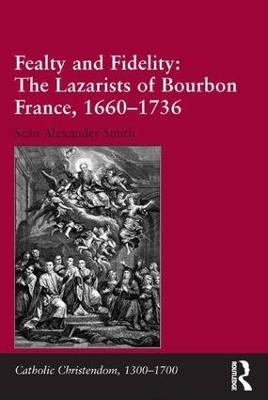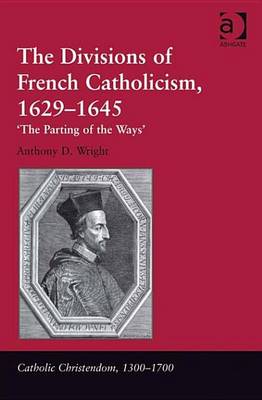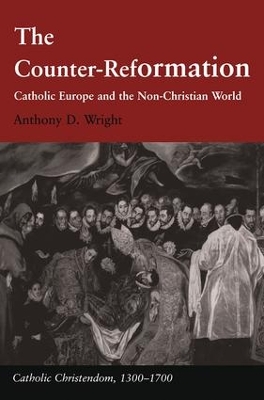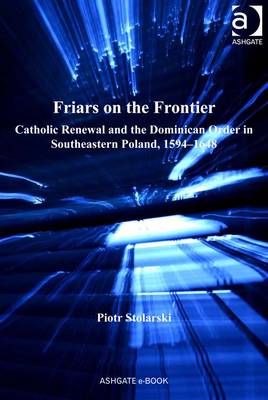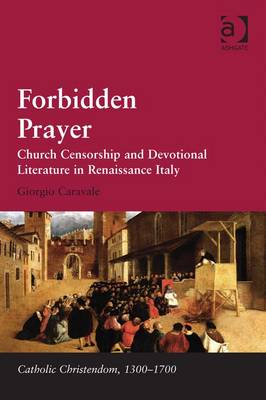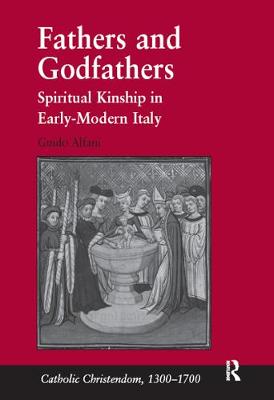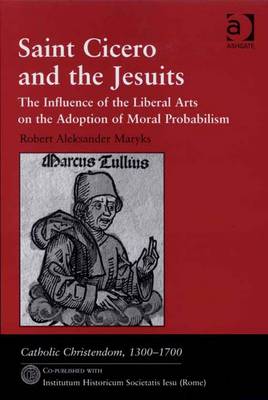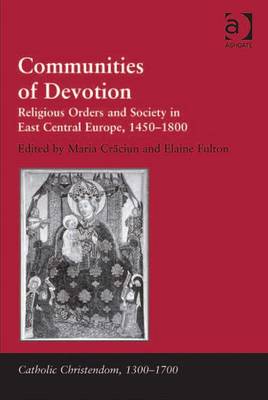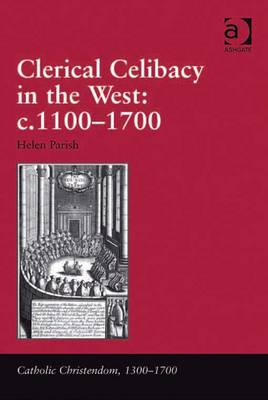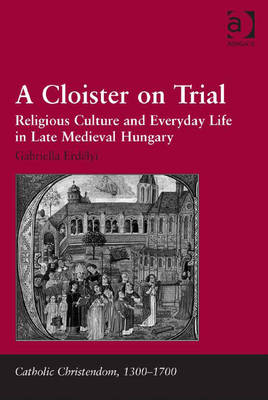Catholic Christendom, 1300-1700
14 total works
Fealty and Fidelity: The Lazarists of Bourbon France, 1660-1736
by Dr. Sean Alexander Smith
The career of the French saint Vincent de Paul has attracted the attention of hundreds of authors since his death in 1660, but the fate of his legacy - entrusted to the body of priests called the Congregation of the Mission (Lazarists) - remains vastly neglected. De Paul spent a lifetime working for the reform of the clergy and the evangelization of the rural poor. After his death, his ethos was universally lauded as one of the most important elements in the regeneration of the French church, but what happened to this ethos after he died? This book provides a thorough examination of the major activities of de Paul’s immediate followers. It begins by analysing the unique model of religious life designed by de Paul - a model created in contradistinction to more worldly clerical institutes, above all the Society of Jesus. Before he died, de Paul made very clear that fidelity to this model demanded that his disciples avoid the corridors of power. However, this book follows the subsequent departures from this command to demonstrate that the Congregation became one of the most powerful orders in France. The book includes a study of the termination of the little-known Madagascar mission, which was closed in 1671. This mission, replete with colonial scandal and mismanagement, revealed the terrible pressures on de Paul’s followers in the decade after his demise. The end of the mission occasioned the first major reassessment of the Congregation’s goals as a missionary institute, and involved abandoning some of the goals the founder had nourished. The rest of the book reveals how the Lazarists recovered from the setbacks of Madagascar, famously becoming parish priests of Louis XIV at Versailles in 1672. From then on, fealty to Louis XIV gradually trumped fidelity to de Paul. The book also investigates the darker side of the Congregation’s novel alliance with the monarch, by examining its treatment of Huguenot prisoners at Marseille later in the century, and its involvement with the slave trade in the Indian Ocean. This study is a wide-ranging investigation of the Lazarists’ activities in the French Empire, ultimately concluding that they eclipsed the Society of Jesus. Finally, it contributes new information to the literature on Louis XIV’s prickly relationship with religious agents that will surprise historians working in this area.
Franciscan Spirituality and Mission in New Spain, 1524-1599
by Steven E. Turley
Franciscans in sixteenth-century New Spain were deeply ambivalent about their mission work. Fray Juan de Zumarraga, the first archbishop of Mexico, begged the king to find someone else to do his job so that he could go home. Fray Juan de Ribas, one of the original twelve 'apostles of Mexico' and a founding pillar of the church in New Spain, later fled with eleven other friars into the wilderness to escape the demands of building that church. Fray Jeronimo de Mendieta, having returned from an important preaching tour in New Spain, wrote to his superior that he did not want to enlist again, and that the only way he would return to the mission field was if God dragged him by the hair.
This discontent was widespread, grew stronger with time, and carried important consequences for the friars' interactions with indigenous peoples, their Catholic co-laborers, and colonial society at large. This book examines that discontent and seeks to explain why the exhilaration of joining such a 'glorious' enterprise so often gave way to grinding discontent.
The core argument is that, despite St. Francis's own longing to do mission work, his followers in New Spain found that effective evangelization in a frontier context was fundamentally incompatible with their core spirituality. Bringing together two streams of historiography that have rarely overlapped - spirituality and missions - this book marks a strong contribution to the history of spirituality in both Latin America and Europe, as well as to the growing fields of transatlantic and world history.
For much of the sixteenth-century, France was wracked with religious strife, as the Wars of Religion pitted Catholic against Protestant. Whilst the conversion of Henri IV to Catholicism ended much of the conflict, the ensuing peace highlighted the fractious nature of French Catholicism and the many competing threads that ran through it. This book investigates the gradual division of the French Catholic reform movement, often associated with those known as the 'devots' during the first half of the seventeenth century. Such division, it is argued, was emerging before the publication in France (1641) of the posthumous 'Augustinus' of Jansenius, not simply as a sequel to that. Those who were already distinguishing themselves from other 'devots' before that date were thus not yet identifiable as 'Jansenists'. Rather, the initial defining sentiment was increasing French hostility towards Jesuit involvement in Catholic Reform, both at home and abroad.
Drawing on sources from the Jesuit archives in Rome and on Port-Royal material in Paris, the book begins with an investigation into the development of Catholic Reform in France, showing the problems that emerged before 1629 and the degree to which these were or were not resolved. The second half of the book contrasts the fragmentation of the movement in the years beyond 1629, and the context of Richelieu's new directions in French foreign policy.
Covering a crucial period in the lead up to the establishment of an absolute monarchy in France, this book provides a rich new explanation of the development of French political and ecclesiastical history. It will be of interest not only to those studying the early modern period, but to anyone wishing to understand the roots of French secular society.
In spite of an upsurge in interest in the social history of the Catholic community and an ever-growing body of literature on early modern 'superstition' and popular religion, the English Catholic community's response to the invisible world of the preternatural and supernatural has remained largely neglected. Addressing this oversight, this book explores Catholic responses to the supernatural world, setting the English Catholic community in the contexts of the wider Counter-Reformation and the confessional culture of early modern England. In so doing, it fulfils the need for a study of how English Catholics related to manifestations of the devil (witchcraft and possession) and the dead (ghosts) in the context of Catholic attitudes to the supernatural world as a whole (including debates on miracles). The study further provides a comprehensive examination of the ways in which English Catholics deployed exorcism, the church's ultimate response to the devil.
Whilst some aspects of the Catholic response have been touched on in the course of broader studies, few scholars have gone beyond the evidence contained within anti-Catholic polemical literature to examine in detail what Catholics themselves said and thought. Given that Catholics were consistently portrayed as 'superstitious' in Protestant literature, the historian must attend to Catholic voices on the supernatural in order to avoid a disastrously unbalanced view of Catholic attitudes. This book provides the first analysis of the Catholic response to the supernatural and witchcraft and how it related to a characteristic Counter-Reformation preoccupation, the phenomenon of exorcism.
Focusing on the Dominican Order's activities in southeastern Poland from the canonisation of the Polish Dominican St Hyacinth (1594) to the outbreak of Bogdan Chmielnicki's Cossack revolt (1648-54) this book reveals the renovation and popularity of the pre-existing Mendicant culture of piety in the period following the Council of Trent (1545-64). In so doing, it questions both western and Polish scholarship regarding the role of the Society of Jesus, and the changes within Catholicism associated with it across Europe in the early modern period. By grounding the rivalry between Dominicans and Jesuits in patronage, politics, preaching, and the practices of piety, the study provides a holistic explanation of the reasons for Dominican expansion, the ways in which Catholicisation proceeded in a consensual political system, and suggests a corrective to the long-standing Jesuit-centred model of religious renewal.
Whilst engaging with existing research regarding the post-Reformation formation of religious denominations, the book significantly expands the debate by stressing the friars' continuity with the medieval past, and demonstrating their importance in the articulation of Catholic-noble identity. Consequently, the monograph opens up new vistas on the history of the Counter-Reformation, Polish-Lithuanian noble identity, and the nature of religious renewal in a multi-ethnic and multi-denominational state.
This book delineates the attempt, carried out by the Congregations of the Inquisition and the Index during the sixteenth and early seventeenth century, to purge various devotional texts in the Italian vernacular of heterodox beliefs and superstitious elements, while imposing a rigid uniformity in liturgical and devotional practices.
The first part of the book is focused on Rome's anxious activity toward the infiltration of Protestant ideas in vernacular treatises on prayer meant for mass consumption. It next explores how, only in the second half of the sixteenth century, once Rome's main preoccupation toward Protestant expansion had subsided, the Church could begin thinking about a move from a rejection of any consideration of the merits of interior prayer to a recovery and acceptance of mental prayer. The final section is dedicated to the primary objective of the Church's actions in purging superstitious practices which was not simply the renewal of the spiritual life of the faithful, but also the control of the religious and social life of many faithful who were uneducated.
Based on a careful examination of the archival records of the two Roman dicasteri in question, many of which have only been accessible to scholars since 1998, as well as a close reading of the many of suspect devotional texts themselves, this book offers a fascinating contribution towards a fuller appreciation of the complex landscape that characterized the spiritual realities of early modern Italy.
In medieval Europe baptism did not merely represent a solemn and public recognition of the 'natural' birth of a child, but was regarded as a second, 'spiritual birth', within a social group often different from the child's blood relations: a spiritual family, composed of godfathers and godmothers. By analyzing the changing theological and social nature of spiritual kinship and godparenthood between 1450 and 1650, this book explores how these medieval concepts were developed and utilised by the Catholic Church in an era of reform and challenge. It demonstrates how such ties continued to be of major social importance throughout the sixteenth and seventeenth centuries, but were often used in ways not always coherent with their original religious meaning, and which could have unexpected social consequences.
In particular, the book analyzes in detail the phase of transition from the traditional model of godparenthood which allowed for multiple godparents, to the new couple model (one godfather and one godmother) imposed by Tridentine law. Drawing upon a large database of archival data taken from parish books of baptisms and marriages, pastoral visitations, diocesan statutes, synods and provincial councils, it is shown how attempts were made to resist or to compromise with the Church, thus providing a better understanding of the often contested meaning given to godparenthood by early modern society.
Whilst the Church was ultimately successful in imposing its will, the book concludes that this was to have unexpected results that were to eventually weaken the role of godparents. Rather than persuading parents to choose real 'spiritual tutors' to act as godparents, the choice of godparents became increasingly influenced with social status, so that godparenthood began to resemble a pure clientele system, something it had never been before.
Through this long-term exploration of Catholic spiritual kinship, much is revealed, not only about godparenthood, but about the wider social and religious networks. Comparison with Protestant reactions to the same issues provides further insight into the importance of this subject to early modern European society.
In this commanding study, Dr Maryks offers a detailed analysis of early modern Jesuit confessional manuals to explore the order's shifting attitudes to confession and conscience. Drawing on his census of Jesuit penitential literature published between 1554 and 1650, he traces in these works a subtly shifting theology influenced by both theology and classical humanism. In particular, the roles of 'Tutiorism' (whereby an individual follows the law rather than the instinct of their own conscience) and 'Probabilism' (which conversely gives priority to the individual's conscience) are examined.
It is argued that for most of the sixteenth century, books such as Juan Alfonso de Polanco's Directory for Confessors espousing a Tutiorist line dominated the market for Jesuit confessional manuals until the seventeenth century, by which time Probabilism had become the dominating force in Jesuit theology.
What caused this switch, from Tutiorism to Probablism, forms the central thesis of Dr Maryks' book. He believes that as a direct result of the Jesuits adoption of a new ministry of educating youth in the late 1540s, Jesuit schoolmasters were compelled to engage with classical culture, many aspects of which would have resonated with their own concepts of spirituality. In particular Ciceronian humanitas and civilta, along with rhetorical principles of accommodation, influenced Jesuit thinking in the revolutionary transition from medieval Tutiorism to modern Probabilism.
By integrating concepts of theology, classical humanism and publishing history, this book offers a compelling account of how diverse forces could act upon a religious order to alter the central beliefs it held and promulgated.
This book is published in conjunction with the Jesuit Historical Institute series 'Bibliotheca Instituti Historici Societatis Iesu'.
Communities of Devotion
Between the later middle ages and the eighteenth century, religious orders were in the vanguard of reform movements within the Christian church. Recent scholarship on medieval Europe has emphasised how mendicants exercised a significant influence on the religiosity of the laity by actually shaping their spirituality and piety. In a similar way for the early modern period, religious orders have been credited with disseminating Tridentine reform, training new clergy, gaining new converts and bringing those who had strayed back into the fold. Much about this process, however, still remains unknown, particularly with regards to east central Europe.
Exploring the complex relationship between western monasticism and lay society in east central Europe across a broad chronological timeframe, this collection provides a re-examination of the level and nature of interaction between members of religious orders and the communities around them. That the studies in this collection are all located in east central Europe - Transylvania, Hungary, Austria, and Bohemia- fulfils a second key aim of the volume: the examination of clerical and lay piety in a region of Europe almost entirely ignored by western scholarship.
As such the volume provides an important addition to current scholarship, showcasing fresh research on a subject and region on which little has been published in English. The volume further contributes to the reintegration of eastern and western European history, expanding the existing parameters of scholarly discourse into late medieval and early modern religious practice and piety.
The debate over clerical celibacy and marriage had its origins in the early Christian centuries, and is still very much alive in the modern church. The content and form of controversy have remained remarkably consistent, but each era has selected and shaped the sources that underpin its narrative, and imbued an ancient issue with an immediacy and relevance. The basic question of whether, and why, continence should be demanded of those who serve at the altar has never gone away, but the implications of that question, and of the answers given, have changed with each generation.
In this reassessment of the history of sacerdotal celibacy, Helen Parish examines the emergence and evolution of the celibate priesthood in the Latin church, and the challenges posed to this model of the ministry in the era of the Protestant Reformation. Celibacy was, and is, intensely personal, but also polemical, institutional, and historical. Clerical celibacy acquired theological, moral, and confessional meanings in the writings of its critics and defenders, and its place in the life of the church continues to be defined in relation to broader debates over Scripture, apostolic tradition, ecclesiastical history, and papal authority. Highlighting continuity and change in attitudes to priestly celibacy, Helen Parish reveals that the implications of celibacy and marriage for the priesthood reach deep into the history, traditions, and understanding of the church.
In 1517, the usually tranquil friary in the Hungarian town of Koermend found itself at the centre of controversy when its Augustinian friars, charged with drunkenness, sexual abuses and liturgical negligence, were driven out and replaced with observant Franciscans. The agent of change in this conflict, cardinal Thomas Bakocz, claimed to be acting in the name of 'cloister reform' motivated by a religious agenda, while the Augustinians portrayed themselves as the victims of a political game.
Based on the surviving interrogations of a papal enquiry into these events, this book illuminates the tensions and potential conflict that lurked within the religious culture of a seemingly unremarkable and remote town. The story of the friary trial of Koermend provides a fascinating window into religion and society of Europe at the dawn of the Reformation, investigating the processes by which ordinary people emerge as historical agents from the written records. By focussing on their experiences as represented in the trial documents the book reveals the spaces and borders of individual and communal action within the dynamic of lay-clerical relations negotiated in a friary reform at the beginning of the 16th century. Furthermore, the moral nature of the accusations levelled at the Augustinians - and whether these were justified or instigated for political reasons - offers further insights into the nature of late-medieval Catholicism and the claims of Protestant reformers.
Juan de Valdes played a pivotal role in the febrile atmosphere of sixteenth-century Italian religious debate. Fleeing his native Spain after the publication in 1529 of a book condemned by the Spanish Inquisition, he settled in Rome as a political agent of the emperor Charles V and then in Naples, where he was at the centre of a remarkable circle of literary and spiritual men and women involved in the religious crisis of those years, including Peter Martyr Vermigli, Marcantonio Flaminio, Bernardino Ochino and Giulia Gonzaga. Although his death in 1541 marked the end of this group, Valdes' writings were to have a decisive role in the following two decades, when they were sponsored and diffused by important cardinals such as Reginald Pole and Giovanni Morone, both papal legates to the Council of Trent. The most famous book of the Italian Reformation, the Beneficio di Cristo, translated in many European languages, was based on Valdes' thought, and the Roman Inquisition was very soon convinced that he had `infected the whole of Italy'.
In this book Massimo Firpo traces the origins of Valdes' religious experience in Erasmian Spain and in the movement of the alumbrados, and underlines the large influence of his teachings after his death all over Italy and beyond. In so doing he reveals the originality of the Italian Reformation and its influence in the radicalism of many religious exiles in Switzerland and Eastern Europe, with their anti-Trinitarians and finally Socinian outcomes. Based upon two extended essays originally published in Italian, this book provides a full up-dated and revised English translation that outlines a new perspective of the Italian religious history in the years of the Council of Trent, from the Sack of Rome to the triumph of the Roman Inquisition, reconstructing and rethinking it not only as a failed expansion of the Protestant Reformation, but as having its own peculiar originality. As such it will be welcomed by all scholars wishing to further their understanding of Italian spiritual reform, and its effect upon the wider currents of the Reformation.
Bringing together leading international scholars, this collection offers a coherent and nuanced consideration of the meaning of a "missionary Catholicisma (TM) and its evolving relationship with newly discovered cultures and political and ecclesiastical authorities. Focusing squarely on the missionaries themselves, the essays draw upon history, theology, religious studies, and cultural theory to illuminate the expansion of Christianity, and Catholicism in particular, from the sixteenth to the eighteenth century.
